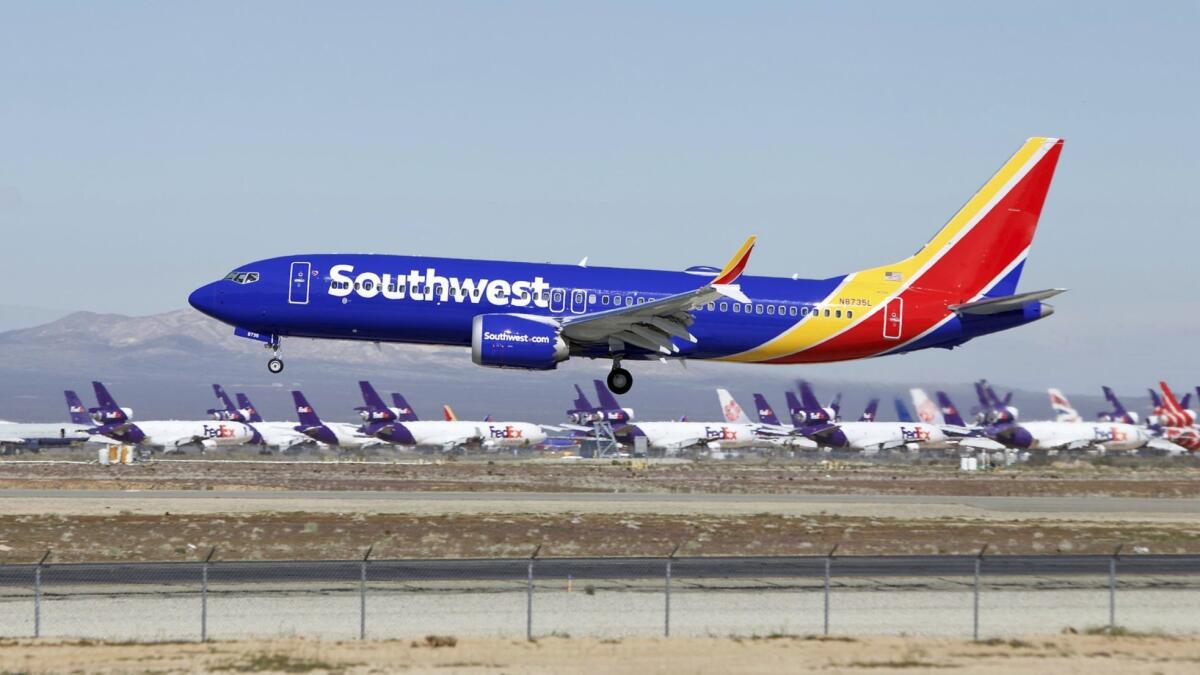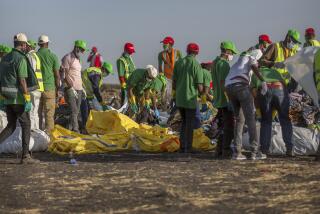Boeing says it will update 737 Max software that was implicated in crashes

Boeing Co. will modify the flight control system of its 737 Max jetliner so its software cannot send the aircraft into a series of uncontrolled dives, as it may have done in two crashes over the last five months, the company said Wednesday.
In an additional step, Boeing will also recommend increased pilot training and make standard a cockpit display of data from air flow sensors outside the plane.
The changes are Boeing’s attempt to respond to preliminary findings that automated features in the 737 Max’s flight control system may have contributed to two fatal crashes: a Lion Air flight in Indonesia that killed 189 people in October and an Ethiopian Airlines flight in March that killed 157.
The company and its federal regulators have been criticized for responding slowly to potential similarities in the two crashes. As one country after another grounded hundreds of 737 Max planes, the Federal Aviation Administration and Boeing delayed acting in the U.S. Boeing has repeatedly said the 737 is safe, and a company vice president reiterated that sentiment during a Wednesday media briefing in Renton, Wash.
Several U.S. airlines said the announced upgrades to the 737 Max appeared to be adequate. But Boeing may have suffered lasting damage to its reputation from its slow response, one aviation safety expert said.
“Had all these mitigations that are now being identified been implemented in the initial release of the aircraft, then we would not be here,” said Thomas Anthony, director of USC’s Viterbi Aviation Safety and Security Program. “They’re going to need to invest a great deal of time and energy in reestablishing their reputation for integrity.”
Boeing didn’t say how soon the software change would be implemented. But it requires approval by the FAA and foreign aviation regulators, and no timetable has been set. The impact on airlines was quantified Wednesday when Southwest Airlines, the largest user of the 737 Max planes, said the groundings along with weather and labor issues had forced cancellation of 9,400 flights from mid-February through the end of March, Bloomberg reported. The airline flies 4,000 flights a day.
The Chicago aerospace giant said the Maneuvering Characteristics Augmentation System, or MCAS, will now utilize readings from two “angle of attack” sensors on the 737 Max. Previously, the system could respond to data from just one sensor, which was found to be faulty in the Lion Air disaster. If data from the two sensors disagree by 5.5 degrees or more with wing flaps retracted, MCAS will be disabled.
Boeing said a flight deck indicator — which shows the actual value of disagreement between the angle of attack sensors — could be retrofitted on previously delivered planes and will be made available at no additional charge if customers choose. A separate alert that will show whether the angle-of-attack sensors disagree will be standard on all 737 Max planes.
Although there have been many suggestions that airlines make that kind of gauge standard in the cockpit, there are no current procedures on how exactly it would assist pilots and it might not “significantly reduce the number of stall accidents,” said Douglas Moss, an instructor at USC’s aviation program, a former United Airlines captain, an attorney and a former Air Force test pilot.
“There is no hard evidence that having an AOA indicator in the cockpit would have prevented any accidents,” he said in an email. “Normally, pilots have adequate indications when they are in a stall.”
The causes of the two crashes have not yet been determined, but early findings suggest MCAS may have played a role.
In the Lion Air crash, a preliminary report suggested a faulty reading from the angle-of-attack sensor may have triggered the MCAS system to send the plane into a series of 26 dives at less than 5,000 feet. It’s not clear whether the Lion Air pilots knew about the MCAS system; U.S. pilots unions have said they were not told about the system before the Indonesian Airlines crash.
Boeing said Wednesday that the new software update will prevent repeated activation of the system in unusual conditions and that, based on testing, there were “no known or envisioned failure conditions” in which the updated flight control system would trigger repeatedly.
Pilots will now receive computer training to give them “enhanced understanding” of the MCAS function, existing crew procedures and related software changes, Boeing said in an overview of the changes provided to industry officials and the media at its Renton facility. As part of the new training, pilots will be required to review a checklist and handbook that have been updated with the changes.
How a 50-year-old design came back to haunt Boeing with its troubled 737 Max jet »
Southwest, American and United airlines, which all operate the 737 Max, expressed confidence in their operation of the plane.
“After reviewing Boeing’s presentation on the updated 737 Max aircraft software, we are optimistic that the updates address the reported concerns about the MCAS system,” Michael Quiello, United vice president of corporate safety, said in an emailed statement.
Bob Waltz, Southwest Airlines’ certificate chief pilot, said in a statement that the airline was “encouraged” by Boeing’s update and would look to the FAA’s final guidance. Southwest, the largest domestic carrier, has 34 of the 737 Max planes in its fleet and an additional 219 on order.
But a spokesman for WestJet Airlines struck a more cautious note, saying the Canadian airline would review Boeing’s software updates and proposed training before putting the 737 Max back into service.
While the Max remains grounded, WestJet will not take delivery of two more planes that the airline had planned to receive this year from Boeing.
“If our next delivery is before the grounding is lifted, we will not take the aircraft,” said spokesman Morgan Bell, noting that Boeing suspended deliveries when the grounding order was given. “However, if the grounding has been lifted and the aircraft is approved for reentry into service by all relevant regulatory bodies, we will take all deliveries as intended.”
Later Wednesday afternoon, federal transportation officials appeared before a Senate subcommittee to discuss federal oversight of U.S. commercial aviation and how to improve safety in light of the recent Ethiopian Airlines crash. The FAA has been criticized for giving Boeing too much control over the 737 Max’s certification.
During the hearing, acting FAA Administrator Daniel Elwell rebutted allegations that the FAA had handed over authority for certifying the 737 Max to Boeing. He also said the decision to not require specific pilot training on MCAS was based on the conclusion that the 737 Max would fly the same as the prior model, the 737 Next Generation, following the unanimous recommendation of a review board that included pilots who flew the test aircraft.
Dennis Tajer, spokesman for the Allied Pilots Assn., which represents American Airlines pilots, said in December that 737 pilots could qualify to fly newer Max versions by taking just an hourlong iPad lesson.
Elwell said the ability of pilots to counteract the MCAS problem, which caused the stabilizer to move out of trim, is part of the preliminary training they receive and is no different from the procedures to handle any type of so-called runaway stabilizer trim.
“I am confident of the angle of attack vanes and I am confident in the MCAS system,” Elwell told the subcommittee.
Elwell said in a statement that the FAA was “directly involved” in the system safety review of MCAS.
“The certification process was detailed and thorough, but, as is the case with newly certified products, time yields more data to be applied for continued analysis and improvement,” he said in the statement. “As we obtain pertinent information, identify potential risk, or learn of a system failure, we analyze it, we find ways to mitigate the risk, and we require operators to implement the mitigation. And that is what has happened in the case of the 737 Max.”
Elwell was repeatedly asked why the U.S. was the last nation to ground the 737 Max. Until satellite data showed that the flight tracks of the Lion Air and Ethiopian Airlines crashes were similar, the FAA did not have data to justify a grounding, he said.
“The U.S. and Canada were the first countries to ground the plane with data,” he said.
The FAA is still reviewing a proposed MCAS software update submitted for certification in January by Boeing. Testing has included “aerodynamic stall situations and recovery procedures,” Elwell said in the statement.
Twitter: @smasunaga
More to Read
Inside the business of entertainment
The Wide Shot brings you news, analysis and insights on everything from streaming wars to production — and what it all means for the future.
You may occasionally receive promotional content from the Los Angeles Times.













